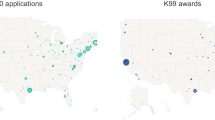Abstract
The study aims to explore variation in scholarly productivity outcomes by underrepresented status among a diverse sample of researchers in a community-engaged training program. We identified 141 trainees from a web-based survey of researchers in the National Cancer Institute-funded, Community Networks Program Centers (CNPCs) (2011–2016). We conducted a series of multiple logistic regression models to estimate the effect of National Institutes of Health (NIH)-defined underrepresented status on four, self-reported, scholarly productivity outcomes in the previous 5 years: number of publications (first-authored and total) and funded grants (NIH and any agency). Sixty-five percent (n = 92) indicated NIH underrepresented status. In final adjusted models, non-NIH underrepresented (vs. underrepresented) trainees reported an increased odds of having more than the median number of total publications (> 9) (OR = 3.14, 95% CI 1.21–8.65) and any grant funding (OR = 5.10, 95% CI 1.77–14.65). Reporting ≥ 1 mentors (vs. none) was also positively associated (p < 0.05) with these outcomes. The CNPC underrepresented trainees had similar success in first-authored publications and NIH funding as non-underrepresented trainees, but not total publications and grants. Examining trainees’ mentoring experiences over time in relation to scholarly productivity outcomes is needed.
Similar content being viewed by others
References
Adams SA, Choi SK, Khang L, Campbell DA, Friedman DB, Eberth JM, … & Young VM (2015) Decreased cancer mortality-to-incidence ratios with increased accessibility of federally qualified health centers. J Community Health 40(4):633–641. https://doi.org/10.1007/s10900-014-9978-8
Kato I, Booza J, Quarshie WO, Schwartz K (2012) Persistent socioeconomic inequalities in cancer survival in the United States: 1973-2007 surveillance, epidemiology and end results (SEER) data for breast cancer and non-Hodgkin’s lymphoma. J Registry Manag 39(4):158–166
Chen MS, Lara PN, Dang JHT, Paterniti DA, Kelly K (2014) Twenty years post-NIH revitalization act: enhancing minority participation in clinical trials (EMPaCT): laying the groundwork for improving minority clinical trial accrual. Cancer 120:1091–1096. https://doi.org/10.1002/cncr.28575
American Cancer Society (2017) Cancer Facts and Figures 2017
Elk R, Landrine H (2012) Cancer disparities: causes and evidence-based solutions. Springer Publishing Company, Berlin
National Cancer Institute (2015) Community Network Program Centers. Available: http://www.cancer.gov/about-nci/organization/crchd/disparities-research/cnpc
Maddux WW, Adam H, Galinsky AD (2010) When in Rome ... Learn why the romans do what they do: how multicultural learning experiences facilitate creativity. Personal Soc Psychol Bull 36(6):731–741. https://doi.org/10.1177/0146167210367786
National Institutes of Health (2015) Notice of NIH’s interest in diversity. Available: https://grants.nih.gov/grants/guide/notice-files/NOT-OD-15-053.html
National Science Foundation (2016) National Center for Science and Engineering Statistics, Doctorate Recipients from U.S. Universities: 2014
Ginther DK, Schaffer WT, Schnell J, Masimore B, Liu F, Haak LL, Kington R (2011) Race, ethnicity, and NIH research awards. Science (80- ) 333(6045):1015–1019. https://doi.org/10.1126/science.1196783
Felder TM, Braun KL, Brandt HM, Khan S, Tanjasiri S, Friedman DB, Armstead CA, Okuyemi KS, Hébert JR (2015) Mentoring and training of cancer-related health disparities researchers committed to community-based participatory research. Prog Community Heal Partnerships Res Educ Action 9(S):97–108. https://doi.org/10.1353/cpr.2015.0020
Kellogg Health Scholars (2016) Community track competencies. Available: http://www.kellogghealthscholars.org/about/community.php#competencies
Thorndyke LE, Gusic ME, George JH, Quillen DA, Milner RJ (2006) Empowering junior faculty: Penn states faculty development and mentoring program. Acad Med 81(7):668–673. https://doi.org/10.1097/01.ACM.0000232424.88922.df
Menard S (2002) Applied logistic regression analysis. (No. 106). Sage
Hosmer DW, Lemeshow S (2000) Special topics. Applied logistic regression, 2nd edn. Wiley, New York. https://doi.org/10.1002/0471722146
Greiner KA, Friedman DB, Adams SA, Gwede CK, Cupertino P, Engelman KK, ... & Hébert JR (2014) Effective recruitment strategies and community-based participatory research: community networks program centers’ recruitment in cancer prevention studies. Cancer Epidemiol Biomarkers Prev 23(3):416–423. https://doi.org/10.1158/1055-9965.EPI-13-0760
Braun KL, Nguyen TT, Tanjasiri SP, Campbell J, Heiney SP, Brandt HM, ... & Ma GX (2012) Operationalization of community-based participatory research principles: assessment of the National Cancer Institute’s Community Network Programs. Am J Public Health 102(6):1195–1203. https://doi.org/10.2105/AJPH.2011.300304
Felder TM, Brandt HM, Armstead CA, Cavicchia PP, Braun KL, Adams SA, ... & Daguisé VG (2012) Creating a cadre of junior investigators to address the challenges of cancer-related health disparities: lessons learned from the community networks program. J Cancer Educ 27(3):409–417. https://doi.org/10.1007/s13187-012-0361-0
Braun KL, Tsark JU, Santos L, Aitaoto N, Chong C (2006) Building native Hawaiian capacity in cancer research and programming. Cancer 107(S8):2082–2090. https://doi.org/10.1002/cncr.22157
Hébert JR, Braun KL, Meade CD, Bloom J, Kobetz E (2015) Community-based participatory research adds value to the National Cancer Institute’s research portfolio. Prog Community Heal Partnerships Res Educ Action 9(S):1–4. https://doi.org/10.1353/cpr.2015.0022
Beckett L, Nettiksimmons J, Howell LP, Villablanca AC (2015) Do family responsibilities and a clinical versus research faculty position affect satisfaction with career and work-life balance for medical school faculty?. 2015. J Women's Health 24(6):471–480. https://doi.org/10.1089/jwh.2014.4858
Beech BM, Calles-Escandon J, Hairston KG, Langdon SE, Latham-Sadler BA, Bell RA (2013) Mentoring programs for underrepresented minority Faculty in Academic Medical Centers. Acad Med 88(4):541–549. https://doi.org/10.1097/ACM.0b013e31828589e3
Pfund C, Byars-Winston A, Branchaw J, Hurtado S, Eagan K (2016) Defining attributes and metrics of effective research mentoring relationships. AIDS Behav 20(S2):238–248. https://doi.org/10.1007/s10461-016-1384-z
Kniffin K (2007) Accessibility to the PhD and professoriate for first-generation college graduates: review and implications for students, faculty, and campus policies. Am Acad 3:49–79
Author information
Authors and Affiliations
Corresponding author
Rights and permissions
About this article
Cite this article
Felder, T.M., Braun, K.L., Wigfall, L. et al. Mentoring, Training, and Scholarly Productivity Experiences of Cancer-Related Health Disparities Research Trainees: Do Outcomes Differ for Underrepresented Scientists?. J Canc Educ 34, 446–454 (2019). https://doi.org/10.1007/s13187-018-1322-z
Published:
Issue Date:
DOI: https://doi.org/10.1007/s13187-018-1322-z



